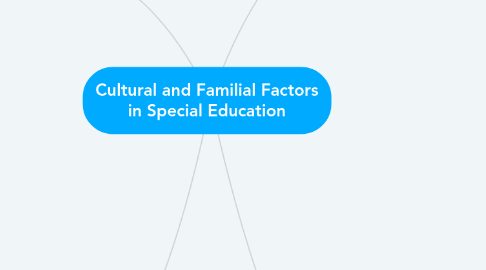
1. Working with Families that are Culturally and Linguistically Diverse
1.1. Develop Partnerships with Families
1.1.1. Have open communication.
1.1.2. Treat families as equal team members.
1.1.3. Respect parents concerns and thoughts.
1.1.4. Invite them to visit the classroom.
1.1.5. Be mindful about body language, tone of speech and facial expressions.
1.2. Strategies to Empower Families
1.2.1. Sharing with parents their rights and the services that can be provided for their student.
1.2.2. Encourage parents to ask questions.
1.2.3. Communicate with families.
1.2.4. Provide families with websites and resources for any additional information they may be looking for.
1.2.5. Be compassionate and remember that all situations are different.
2. Disproportionality in Special Education
2.1. My Current Students
2.1.1. Ethnicity/Race
2.1.1.1. 86% White
2.1.1.2. 4% Hispanic
2.1.1.3. 4% African American
2.1.2. Socioeconomic Status
2.1.2.1. 50% Middle Class
2.1.2.2. 50% Lower Class
2.1.3. Culture
2.1.3.1. 37% live with single parent or foster parents
2.1.3.2. 63% live with both biological parents
2.1.4. Language
2.1.4.1. 100% of students speak English
2.2. Factors Associated with the Disporoportionate Representation in Special Education Classrooms
2.2.1. Urban or Rural Communities
2.2.2. The school's ability to identify students quickly
2.2.3. The family's educational beliefs based on their culture.
2.2.4. The Response to Intervention
2.2.5. Collecting enough of the correct and necessary data
3. Culturally Responsive Practices
3.1. Content Integration
3.1.1. Use content from different cultures to explain key concepts
3.1.1.1. Use a wide range of vocabulary
3.1.1.2. Use different forms of media that positively depict different cultures
3.1.1.3. Positive Student-Teacher Relationship
3.2. Knowledge Construction
3.2.1. Allow students to understand and research the assumptions or biases and how it can affect their knowledge.
3.2.1.1. Use media to share about different cultures.
3.2.1.2. Use holidays or times of the year as teachable moments.
3.2.1.2.1. Martin Luther King, Jr. Day
3.2.1.2.2. President's Day
3.3. Equity Pedagogy
3.3.1. Allow all students from diverse groups to achieve in class and be leaders.
3.3.1.1. Learn about your students
3.3.1.2. Call on all students so that the whole group is able to hear different responses
3.4. Prejudice Reduction
3.4.1. Use specific materials or methods that would demonstrate how prejudices arise and can be reduced.
3.4.1.1. Teacher's ability to create a safe classroom environment for all students to learn and share their ideas.
3.4.1.2. Talk about bullying and give students strategies to ask for help.
3.5. Empowering School Culture and Social Awareness
3.5.1. Create a school culture that values students from all different backgrounds and cultures.
3.5.1.1. Guest Speakers
3.5.1.2. Interviewing students of different cultures
3.5.1.3. Cook and eat food from other cultures
3.5.1.4. Use appropriate media to share the different cultures around the world.
4. Dimensions of Culture to be Aware of When Working With Families and Students
4.1. Language
4.1.1. English
4.1.2. Spanish
4.1.3. French
4.1.4. Body Language
4.1.5. Tone
4.1.6. Facial Expressions
4.2. Gender Roles
4.2.1. Some cultures have distinct roles for different genders in their culture
4.2.1.1. Father is the provider
4.2.1.2. Mother stays home to care for children.
4.3. Education
4.3.1. High School Graduate
4.3.2. College Graduate
4.3.3. High School Dropout
4.3.4. GED
4.4. Family Roles
4.4.1. Family Roles can be different in every culture. These roles affect title, responsibilities, power, and authority
4.4.1.1. Mother
4.4.1.2. Father
4.4.1.3. Single Parent
4.4.1.4. Foster Parent
4.4.1.5. Grandparent
4.5. Religion
4.5.1. Catholic
4.5.2. Christianity
4.5.3. Lutheran
4.5.4. Baptist
4.6. Socioeconomic Status
4.6.1. Upper Class
4.6.2. Working Class
4.6.3. Lower Middle Class
